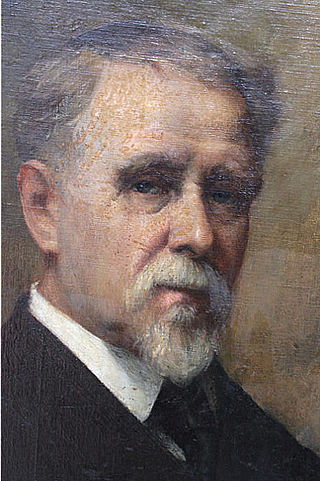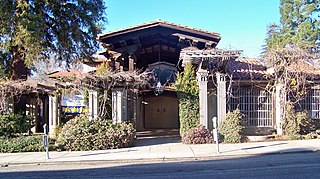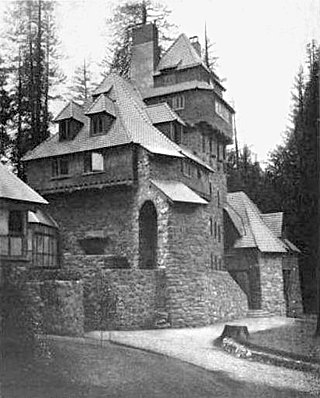
Phoebe Elizabeth Apperson Hearst was an American philanthropist, feminist and suffragist. Hearst was the founder of the University of California Museum of Anthropology, now called the Phoebe A. Hearst Museum of Anthropology, and the co-founder of the National Parent-Teacher Association.

Julia Morgan was an American architect and engineer. She designed more than 700 buildings in California during a long and prolific career. She is best known for her work on Hearst Castle in San Simeon, California.

The Palace of Fine Arts is a monumental structure located in the Marina District of San Francisco, California, originally built for the 1915 Panama–Pacific International Exposition to exhibit works of art. It was constructed from concrete and steel, and the building was claimed to be fireproof. Completely rebuilt from 1964 to 1974, it is the only structure from the exposition that survives on site.

Bernard Ralph Maybeck was an American architect in the Arts and Crafts Movement of the early 20th century. He was an instructor at University of California, Berkeley. Most of his major buildings were in the San Francisco Bay Area.

The Hearst Memorial Mining Building at the University of California, Berkeley, is home to the university's Materials Science and Engineering Department, with research and teaching spaces for the subdisciplines of biomaterials; chemical and electrochemical materials; computational materials; electronic, magnetic, and optical materials; and structural materials. The Beaux-Arts-style Classical Revival building is listed in the National Register of Historic Places and is designated as part of California Historical Landmark #946. It was designed by John Galen Howard, with the assistance of architect and Berkeley alumna Julia Morgan and the Dean of the College of Mines at that time, Samuel B. Christy. It was the first building on that campus designed by Howard. Construction began in 1902 as part of the Phoebe Hearst campus development plan. The building was dedicated to the memory of her husband George Hearst, who had been a successful miner.

The University House is a residence and venue for official events on the campus of the University of California, Berkeley. Designed by the architect Albert Pissis and completed in 1911, it was formerly named President's House while it served as the home of the president of the University of California, starting with Benjamin Ide Wheeler and ending with Robert Gordon Sproul. Since 1965, it has been the home of the Chancellor of the Berkeley campus.
The William Randolph Hearst Greek Theatre, known locally as simply the Greek Theatre, is an 8,500-seat Greek Theatre owned and operated by the University of California, Berkeley in Berkeley, California, USA.

Henri Jean Émile Bénard was a French architect and painter.

Northside is a principally residential neighborhood in Berkeley, California, located north of the University of California, Berkeley campus, east of Oxford Street, and south of Cedar Street. There is a small shopping area located at Euclid and Hearst Avenues, at the northern entrance to the university. The Graduate Theological Union is located one block west of Euclid Avenue, in an area nicknamed Holy Hill. The north fork of Strawberry Creek runs southwestward across Northside, mostly culverted under buildings and pavement, to the campus.

John Galen Howard was an American architect and educator who began his career in New York before moving to California. He was the principal architect at in several firms in both states and employed Julia Morgan early in her architectural career.
The campus of the University of California, Berkeley, and its surrounding community are home to a number of notable buildings by early 20th-century campus architect John Galen Howard, his peer Bernard Maybeck, and their colleague Julia Morgan. Subsequent tenures as supervising architect held by George W. Kelham and Arthur Brown, Jr. saw the addition of several buildings in neoclassical and other revival styles, while the building boom after World War II introduced modernist buildings by architects such as Vernon DeMars, Joseph Esherick, John Carl Warnecke, Gardner Dailey, Anshen & Allen, and Skidmore, Owings and Merrill. Recent decades have seen additions including the postmodernist Haas School of Business by Charles Willard Moore, Soda Hall by Edward Larrabee Barnes, and the East Asian Library by Tod Williams Billie Tsien Architects.

Joseph Henry Sharp was an American painter and a founding member of the Taos Society of Artists, of which he is considered the "Spiritual Father". Sharp was one of the earliest European-American artists to visit Taos, New Mexico, which he saw in 1893 with artist John Hauser. He painted American Indian portraits and cultural life, as well as Western landscapes. President Theodore Roosevelt commissioned him to paint the portraits of 200 Native American warriors who survived the Battle of the Little Bighorn. While working on this project, Sharp lived on land of the Crow Agency, Montana, where he built Absarokee Hut in 1905. Boosted by his sale of 80 paintings to Phoebe Hearst, Sharp quit teaching and began to paint full-time.

First Church of Christ, Scientist, Berkeley, now also known as Christian Science Society, Berkeley, is a Christian Science church, located at 2619 Dwight Way at Bowditch Street across the street from People's Park, in Berkeley, in Alameda County, California.
This is an incomplete list of historic properties and districts at United States colleges and universities that are listed on the National Register of Historic Places (NRHP). This includes National Historic Landmarks (NHLs) and other National Register of Historic Places listings. It includes listings at current and former educational institutions.

Wyntoon is a private estate in rural Siskiyou County, California, owned by the Hearst Corporation. Architects Willis Polk, Bernard Maybeck and Julia Morgan all designed structures for Wyntoon, beginning in 1899.

Charles Stetson Wheeler was an American attorney who served as a Regent of the University of California, and he was a member of the Committee of Fifty working to maintain order after the devastating fire following the earthquake of 1906 in San Francisco. Wheeler was active in Republican Party politics.

A. C. Schweinfurth (1864–1900), born Albert Cicero Schweinfurth, was an American architect. He is associated with the First Bay Tradition, an architectural style from the period of the 1880s to early 1920s.

The First Unitarian Church in Berkeley, California is a former church building that was built in 1898. It was designed by Albert C. Schweinfurth, who made unconventional use of Shingle Style architecture, usually applied to homes, in designing a church. It was also highly unusual for a church building in several other ways, including the use of industrial-style metal sash windows, sections of redwood tree trunks as pillars, the strong horizontal emphasis, and a semicircular apse with a conical roof.The building is listed on the National Register of Historic Places, the California State Historic Resources Survey, and is a City of Berkeley Landmark. It has also been known as University Dance Studio and Bancroft Dance Studio for its current use.

The Unitarian Universalist Church of Berkeley (UUCB) was founded as the First Unitarian Church of Berkeley in Berkeley, California in 1891 and moved to Kensington, California in 1961. It is one of the oldest and largest Unitarian Universalist churches on the West Coast and has had many distinguished members, including numerous professors at the University of California, Berkeley. It is highly regarded for its music program as well as its series of renowned ministers and its many avenues for spiritual growth, learning, and social action.





















